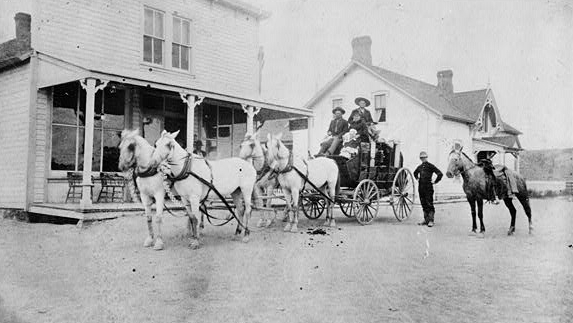
Deadwood Stage at Chugwater Station, 1884
The Above photo shows the Deadwood Stage,
with George Lathrop driver, at the home ranch of the Swan Land and Cattle Co. Ltd.,
in Chugwater. The building to the right was the manager's house. The station
burned in 1918. Presently, the Swan office building sits on its site.
Although not as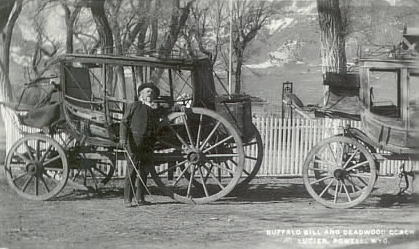 significant as the Overland
Stage, probably no stage line
has attracted more attention than
the Deadwood Stage, more properly, the Blackhills Stage and
Express Line. The attack upon the Deadwood Stage was a centerpiece
of Wm. F. Cody's Wild West Show, photo of Cody next to Deadwood Stage,
left. The coach depicted was constructed by the Abbot-Downing Co., Concord,
N.H. in 1863 and was shipped to the Pioneer Stage Co., San Francisco, around Cape
Horn on the clipper ship General Grant. The coach was taken by Cody to Europe twice
where it was billed as the "Most Famous Vehicle Extant." Among those given
rides in the coach on its European tours was the Prince of Wales, later Edward VII.
The coach currently on an touring exhibit sponsored by a British museum is an original
Deadwood Stage purchased by Col. Cody in 1911. significant as the Overland
Stage, probably no stage line
has attracted more attention than
the Deadwood Stage, more properly, the Blackhills Stage and
Express Line. The attack upon the Deadwood Stage was a centerpiece
of Wm. F. Cody's Wild West Show, photo of Cody next to Deadwood Stage,
left. The coach depicted was constructed by the Abbot-Downing Co., Concord,
N.H. in 1863 and was shipped to the Pioneer Stage Co., San Francisco, around Cape
Horn on the clipper ship General Grant. The coach was taken by Cody to Europe twice
where it was billed as the "Most Famous Vehicle Extant." Among those given
rides in the coach on its European tours was the Prince of Wales, later Edward VII.
The coach currently on an touring exhibit sponsored by a British museum is an original
Deadwood Stage purchased by Col. Cody in 1911. In the Summer of 1876 several attempts
were made to reach Deadwood by stage from Cheyenne
but turned back due to the danger of marauding Indians following their
defeat of Custer at
the Little Big Horn. On Sept. 25, however, Dave Dickey brought the first stage
into Deadwood.

"After the Holdup"
The above photo was, pardon the expression, apparently staged,
but does depict the Deadwood Stage. For another view of a Deadwood stage, see view of
stage parked next to the Lusk Museum below. The stage line initially ran from Cheyenne via Horse Creek,
Bear Springs, Chugwater, Chug Springs, Eagle's Nest, Fort Laramie,
Rawhide Buttes, Hat Creek north of Lusk (pictured below left,
Stage Barn near Lusk, below right), Cheyenne Crossing and on up to Deadwood
through Custer City. The line used both smaller coaches drawn by four
horses and giant
18-passenger coaches pulled by six horses. The
drivers often in arriving at their final destination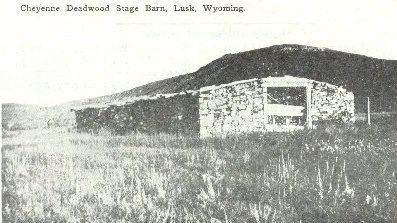 would make "a show of it", thundering into town with the red and yellow Gilman and Salisbury
coaches "licky-cut", pulled by a matched team of six horses.
would make "a show of it", thundering into town with the red and yellow Gilman and Salisbury
coaches "licky-cut", pulled by a matched team of six horses.
With the stages carrying gold, the danger from road agents was always present, indeed,
to such an extent that the line used a ironclad coach named the "Monitor" for
transporting gold. The Monitor, itself, was held up by road agents on September 26, 1878,
near Canyon Springs Station. The guard, Gale Hill, was wounded and one passenger killed. The agents
had little difficulty in breaking open the supposedly impregnable safe used for
carrying the gold. Hill died several years later from complications from his wounds. An armored stage known as
"Old Ironsides" was also used for a three-year period on the Deadwood-Sidney run and was robbed only once.
During one two-month period the Deadwood stage was held up four times by the Sam Bass Gang, consisting of
Bass, Joel Collins, Tom Nixon, Bill Heffridge and Jim Berry.
The first driver killed was Johnny Slaughter on March 25, 1877, driving a stage
bearing eleven passengers and $15,000. The stage was delayed by spring snow and
mud and a breakdown five miles north of Hill City. Two miles outside of
Deadwood road agents led by Sam Bass attempted to rob the stage a fifth time.
In the process
Slaughter was killed, the horses bolted, running off toward town only to be
stopped when the lead horses became entangled in the leads.
Slaughter's body was returned by special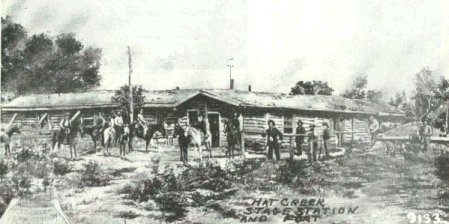 coach to Cheyenne, where his hearse
was drawn by six dappled grays matching the team he had driven in Deadwood.
coach to Cheyenne, where his hearse
was drawn by six dappled grays matching the team he had driven in Deadwood.
The gang fled to Nebraska where they robbed the Union Pacific train at Big Spring
of $60,000 in freshly minted double eagles from the San Fransisco Mint, $450.00
from the mail car safe and $1,300.00 from the passengers. Following the robbery
Collins and Heffridge were killed by a sheriff's posse near Buffalo Station, with
$25,000 being recovered.
Berry was captured at Mexico, Missouri and Nixon disappeared carrying, according
to Berry, $10,000, never to be seen again. Another alleged member of the Bass Gang,
Frank K. Towle, was killed later the same year while attempting to rob the stage.
One of the guards on the stage, Boone May, upon his return to Cheyenne discovered that there
was a price upon Towle's head. May then returned to the scene of the attempted
crime, found Towle's remains, cut off the head, and returned with his gory proof to Cheyenne
in order to collect the reward. Unfortunately, word had already gotten out about
Towle's demise and the reward had been cancelled. Thus, May's trip was for naught and
all he had for his efforts was a rather unusual souvenir. It has been written of May, reputedly the "fastest gun
in the Dakotas," that "his corpses were invariably those of undesireable citizens, never
of the law abiding."
Sixteen months after the killing of Slaughter, Bass was ambushed at Round Rock, Texas, by
Texas Rangers
to whom Bass was betrayed by Jim Murphy, a member of his gang. A compatriot,
Frank Jackson,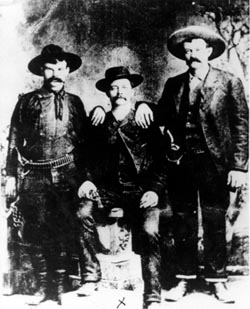 escaped with an indeterminate amount of gold coin, which Bass had
being carrying in his saddlebags. Two days later on his 27th
birthday, July 27, 1878, Bass died from gunshot wounds
received in the ambush, his last words, "The world is bobbing around." escaped with an indeterminate amount of gold coin, which Bass had
being carrying in his saddlebags. Two days later on his 27th
birthday, July 27, 1878, Bass died from gunshot wounds
received in the ambush, his last words, "The world is bobbing around."
Photo to right, L. to R. Bass, Collins and (possibly) Murphy
Others who traveled along the stage road included Martha "Calamity"
Jane Cannary Burk, photo below,
who achieved fame and, allegedly, her name as a result of her rescuing
Capt. Egan from
Indians at Goose Creek Camp (now Sheridan).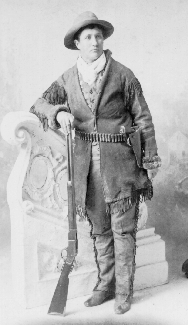 Unfortunately, Calamity
Jane, as a result of alcoholism
was a continuous calamity. In 1874, she was working at a hog ranch
five miles west of
Ft. Laramie. She signed on for several military expeditions as a
bullwacker but was fired
when her gender was discovered. In 1876, she served several terms
in the Cheyenne jail for disturbing the
peace. She then drifted to Deadwood but, after James "Wild Bill" Butler
Hickok's demise at the hand of Jack McCall, continued
to drift. On one stage trip between Custer City and Rock Creek she was
unable to pay her fare and her trunk was retained by the stage line.
It was found to contain only clothes and a photograph of Hickok. Reportedly,
the last place the trunk was seen was in the attic of the pump house at
Ft. Steele. Unfortunately, Calamity
Jane, as a result of alcoholism
was a continuous calamity. In 1874, she was working at a hog ranch
five miles west of
Ft. Laramie. She signed on for several military expeditions as a
bullwacker but was fired
when her gender was discovered. In 1876, she served several terms
in the Cheyenne jail for disturbing the
peace. She then drifted to Deadwood but, after James "Wild Bill" Butler
Hickok's demise at the hand of Jack McCall, continued
to drift. On one stage trip between Custer City and Rock Creek she was
unable to pay her fare and her trunk was retained by the stage line.
It was found to contain only clothes and a photograph of Hickok. Reportedly,
the last place the trunk was seen was in the attic of the pump house at
Ft. Steele.
She ultimately married Clinton Burk in El Paso by whom she had a daughter.
In 1896, after returning to Deadwood, Burk departed town
after embezzling money. Jane's daughter was taken from her
and placed in a convent to be reared by the sisters.
In her
"Autobiography", regarded
today as primarily fiction, she claims to have driven the stage in
after Slaughter's death. However,
Wm. F. Cody, recollected that she told the same story with regard
to a stage driven by one Jack McCall,
allegedly wounded by Indians on the Deadwood to Wild Birch run.
In 1901 Calamity Jane was found ill and
drunk in a Negro parlor house in Horr, Mt. Two years later she died,
delirious, in Terry, S.D with her last words being
of her daughter.
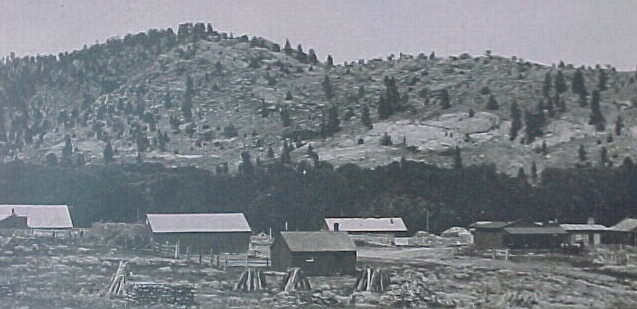
Rawhide Ranch, Rawhide Buttes, 1908
The Rawhide Ranch was owned by Col. Charles F. Coffee whose
home ranch was near Harrison, Nebraska. Coffee Siding, just across the
Nebraska line near Van Tassell, was established by Col. Coffee. Cattle would be trailed to
the siding from Niobrara and Goshen Counties in order to avoid higher freight rates
for cattle shipped from Wyoming. At its peak as many as five train loads of
cattle would be shipped daily from Coffee Siding. Today, Coffee Siding does not
appear on many maps of Nebraska, although Van Tassell, one of the smaller municipalities
in Wyoming, population either 8, 9, or 10 depending on who is doing the counting,
remains on most maps of Wyoming.
The hog ranch at Ft. Laramie was not the only such establishment along the
stage road. At Rawhide Buttes, south of present day Lusk, Mother "Featherlegs" Shephard kept a
parlor where the lads could take their ease. She was called "Featherlegs" because her pantalettes
gave her legs the appearance of chicken legs. In 1879 Mother Featherlegs was murdered
for her money. In 1964 a 3,500 lb. granite monument was erected along the Cheyenne-Deadwood
Stage Road in her memory.
"Featherlegs" Shephard kept a
parlor where the lads could take their ease. She was called "Featherlegs" because her pantalettes
gave her legs the appearance of chicken legs. In 1879 Mother Featherlegs was murdered
for her money. In 1964 a 3,500 lb. granite monument was erected along the Cheyenne-Deadwood
Stage Road in her memory.
The Cheyenne-Deadwood Stage was not the only stage line that had problems
with road agents and danger. In 1863, George Plumb, a young military officer had a
harrowing journey on the Overland Stage.
On July 7, 1863, he was a participant in an all day's
engagement with the Ute Indians in South Pass, in which several soldiers
were killed and several wounded. On his return to the fort he received orders to report to St. Louis. July 9,
1863, he took the stage. At Medicine Bow
the Indians had destroyed the station and the driver
refused to go on until Plumb agreed to ride shotgun.
The station at Rock Creek was also destroyed and the stage was required
to proceed on to the next station without a change of horses.
At "Cachlepowder" [Cache La Poudre] Plumb took
the eastbound Denver stage [At Camp Collins, now Ft. Collins, a branch line from Denver
met the Overland].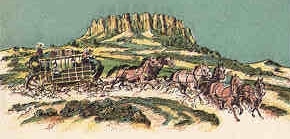 The stage had three passengers, one being David Moffat,
a first cousin once removed of Webmaster's grandfather. At the
Nebraska line, about two miles after Cottonwood Station, the coach was halted by road agents,
but Moffat threw open the
door on one side as did Plumb on the other. Both quickly
climbed to the top while the driver whipped up his horses leaving the road agents in the dust.
The rest of the journey was apparently uneventful. The stage had three passengers, one being David Moffat,
a first cousin once removed of Webmaster's grandfather. At the
Nebraska line, about two miles after Cottonwood Station, the coach was halted by road agents,
but Moffat threw open the
door on one side as did Plumb on the other. Both quickly
climbed to the top while the driver whipped up his horses leaving the road agents in the dust.
The rest of the journey was apparently uneventful.
The Blackhills route lasted only 11 years. Railroads reached much of the
territory served by the line in 1886. Service was, thus, discontinued
with the
last coach, drawn by six horses and driven by George Lathrop accompanied by John Noonan, leaving
Cheyenne from in front of the Inter-Ocean Hotel on Feb. 19, 1887.
By that time ownership of
the line had changed hands and was owned by Russell Thorp.
The route had also changed, the Line's
literature advertising service to Chugwater,
Ft. Laramie, Lusk, Douglas, Buffalo and Deadwood
Deadwood Stage continued on next page.
|